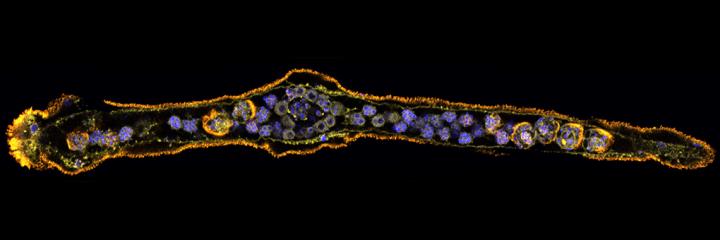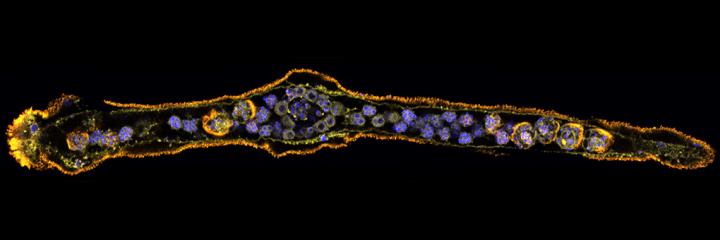
Credit: Okinawa Institute of Science and Technology Graduate University (OIST)
Revealing the origin and evolutionary history of the world's manifold life forms is one way in which we seek to understand them. Even the smallest inhabitant can yield fascinating insights. For example, take the Dicyemida, which are microscopic parasites that live inside cephalopods such as octopuses and cuttlefish. These seemingly inconsequential beings have baffled taxonomists due to their simple body structure, which is composed of around 40 cells and does not include many common body elements such as a circulatory system. Historically, researchers have disagreed about the Dicyemida's classification, including whom their closest relatives are and on which rung of the evolutionary ladder they are situated.
But now, researchers at the Okinawa Institute of Science and Technology Graduate University (OIST) have pinpointed the Dicyemida's proper place on the planet's family tree, placing them within the Spiralia clade–a diverse group of creatures comprising mollusks, flatworms, and others, that sprouted from the same common ancestor. In addition, they are closest to Orthonectida, another phylum of marine parasite within the Spiralia clade. This placement promises new insight not only into Dicyemida but also the evolutionary history of Spiralia and the process of evolution in general. The paper is published in the journal Zoological Letters.
In the 19th century, researchers proposed to classify Dicyemida as a type of mesozoan, which are abstruse, intermediary creatures believed to exist between the two main types of life forms–protozoa, single-celled organisms such as the parasite that causes malaria, and metazoa, multicellular organisms comprising most everything else, including humans. Researchers believed that the mesozoans are an assemblage of degenerate metazoa, or beings that have, in a sense, reversely evolved from an ancestor with a complex body structure into a new organism with a simpler one. Later studies revealed that the Dicyemida may also belong to the Spiralia group.
Yet none of these previous studies could confirm the Dicyemida's position with certainty, and researchers disagreed on the finer points of their placement. Part of the issue had to do with the small amount of data available, and since less data means less certainty, it was unclear which results were more likely to be correct.
"[Previous studies] show that the exact phylogenetic position of Dicyemida is still under debate," says OIST PhD student Tsai-Ming Lu from the Marine Genomics Unit, and first author on the paper. "Even in 2010 there were two publications showing different results…and they only used a small amount of molecular data to try to figure it out."
What makes the OIST team's study unique is that the researchers used next-generation sequencing to obtain a huge amount of data. The type of classification method that the OIST and previous studies' researchers used is carried out by comparing genes among different individuals or groups of creatures and determining which are most alike. To do this, researchers often use DNA and amino acid sequences for comparison. The previous papers that attempted to classify Dicyemida used about 4,500 to 12,000 DNA base pairs, and another only around 400 amino acids. The OIST research team chose to focus on amino acids, and utilized about 58,124.
With this wealth of data, they determined that Dicyemida are indeed mesozoans, as well as part of the Spiralia clade, and most closely related to the Orthonectida.
With this newfound information, the next challenge is to figure out what it all means. "Dicyemida have a very simple body plan," Lu explains. "If they are basal to other spiralian lineages, it means that the common ancestor of Spiralia probably had a very simple body plan and their descendant lineages evolved into more and more complex organisms." If they are not relatively close to the common ancestor, "then Dicyemida managed to reduce and simplify their body plan." In other words, Dicyemida are either part of the first group of creatures to evolve from a common ancestor of the Spiralia clade or they underwent evolutionary simplification for some reason.
Lu supposes that the latter might be true. "[Dicyemida's] secondary reduced morphology may be due to adaptation to a parasitic lifestyle," he explains. "[When] they become parasitic, they don't need so many…functions so they just lose them." It could be that parasites evolve from "free-living" animals into parasites by becoming simpler, losing unnecessary complex functions such as circulatory systems, in order to optimize whatever it is that the parasite needs to be the best parasite.
These suppositions will require much more research to validate, but for now, the OIST research team has added a note of certainly to the long-contested question of where do the Dicyemida belong.
###
Media Contact
Kaoru Natori
[email protected]
81-989-662-389
@oistedu
http://www.oist.jp/
Original Source
https://www.oist.jp/news-center/news/2017/7/18/parasite-revealed-new-insights-dicyemida http://dx.doi.org/10.1186/s40851-017-0068-5





